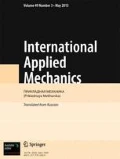Conclusions
We constructed an analytical model of the loading of a specimen with a fatigue crack.
We also designed instruments to detect a signal proportional to the change in the compliance (stiffness) of the test specimen.
An instrument system was also developed to record the kinetics of cracks during long fatigue tests.
Examination of the system in preliminary tests showed it to be highly reliable, providing stable readings of the parameters being recorded.
A method was devised for experimentally studying the kinetics of fatigue fracture of specimens of alloy EP718ID and a cycle of tests was conducted. It was shown that life of the specimen after the formation of a fatigue crack depends on the level of the cyclic stresses and stress concentration.
Similar content being viewed by others
References
A. E. Andreikiv and N. V. Lysak, Method of Acoustic Emission in the Study of Fracture [in Russian], Nauk. Dumka, Kiev (1989).
V. P. Golub, A. D. Pogrebnyak, and A. V. Zheldubovskii, Avt. Svid. No. 1,057,805 SSSR, MKI G 01 No. 3/52. "Method of determining fatigue damage to materials," Otkrytiya. Izobreteniya, No. 44, 157 (1983).
V. P. Golub, "Method of experimentally studying the kinetics of fatigue fracture," Zavod. Lab.,52, No. 9, 67–69 (1986).
I. S. Gradshtein and I. M. Ryzhik, Tables of Integrals, Sums, Series, and Products [in Russian], Fizmatgiz, Moscow (1983).
V. S. Ivanova and V. G. Kudryashov, "Method of determining fracture toughness (KIc) from fatigue test data," Probl. Prochn., No. 3, 17–19 (1970).
A. A. Krasovskii and G. S. Pospelov, Principles of Automation and Engineering Cybernetics [in Russian], Gosnergoizdat, Moscow (1962).
Z. M. Markochev and B. A. Drozdovskii, "Method of evaluating the rate of crack growth and assigning the stress in pulsating loading," Zavod. Lab.,31, No. 3, 345–349 (1965).
P. G. Miklyaev, G. S. Neshpor, and G. V. Kudryashov, Kinetics of Fracture [in Russian], Metallurgiya, Moscow (1979).
J. F. Knott, Principles of Fracture Mechanics [Russian translation], Metallurgiya, Moscow (1978).
V. V. Panasyuk, S. E. Kovchin, and N. S. Kogut, "Method of forming axisymmetric surface cracks in cylindrical specimens," Fiz. Khim. Mekh. Mater.,8, No. 2, 95–97 (1972).
V. V. Panasyuk, A. E. Andreikiv, and S. E. Kovchin, Methods of Evaluating the Fracture Toughness of Structural Materials [in Russian], Nauk. Dumka, Kiev (1977).
A. N. Romanov and N. A. Makhutov, "Study of crack growth during high-temperature single and low-cycle loadings," Zavod. Lab., No. 1, 85–91 (1978).
Ya. A. Rublev, "Ultrasonic unit for automatic recording of the nucleation and growth of fatigue cracks," Zavod. Lab., No. 3, 365–368 (1966).
S. V. Serensen, M. E. Garf, and V. A. Kuz'menko [in Russian], Dynamics of Machines for Fatigue-Testing, Mashinostroenie, Moscow (1967).
V. T. Troshchenko, V. V. Pokorvskii, and A. V. Prokopenko, Fracture Toughness of Metals During Cyclic Loading [in Russian], Nauk. Dumka, Kiev (1987).
M. Ya. Shashin and Yu. A. Buzuev, "Damage to metals at different stages of fatigue," Zavod. Lab.,40, No. 1, 86–88 (1974).
A. A. Anctil, E. B. Kula, and E. DiCesare, "Electrical potential technique for determining slow crack growth," Am. Soc. Test. Mater. Preprint, No. 8 (1963).
A. R. Jack and A. T. Price, "The initiation of fatigue cracks from notches in mild steel plates," Int. J. Fract. Mech.,6, No. 4, 401–409 (1970).
J. D. Lubahu, "Experimental determination of energy release rate for notch bending and notch tension," Am. Soc. Test. Mater. Proc.,59, 885–913 (1959).
T. M. Morton, S. Smith, and R. M. Harrington, "Effect of loading variables on the acoustic emission of fatigue crack growth," Exp. Mech.,14, No. 5, 208–213 (1974).
R. O. Ritchie, G. G. Garrett, and J. E. Knott, "Growth monitoring: optimization of electrical potential technique using an analogue method," Int. J. Fract. Mech.,7, No. 4, 462–467 (1971).
J. Schijve, "Four lectures on fatigue crack growth," Eng. Fract. Mech.,9, No. 1, 167–221 (1977).
E. T. Wessel, "Practical fracture mechanics for structural steel," in: UKAEA. Chapman and Hall (1969), Paper 11.
Additional information
Deceased.
S. P. Timoshenko Institute of Mechanics, National Academy of Sciences of Ukraine, Kiev. Translated from Prikladnaya Mekhanika, Vol. 31, No. 12, pp. 66–74, December, 1995.
Rights and permissions
About this article
Cite this article
Golub, V.P., Butseroga, V.P. & Pogrebnyak, A.D. Study of the kinetics of fatigue cracks by the method of differential compliance. Int Appl Mech 31, 1018–1025 (1995). https://doi.org/10.1007/BF00847262
Received:
Issue Date:
DOI: https://doi.org/10.1007/BF00847262




